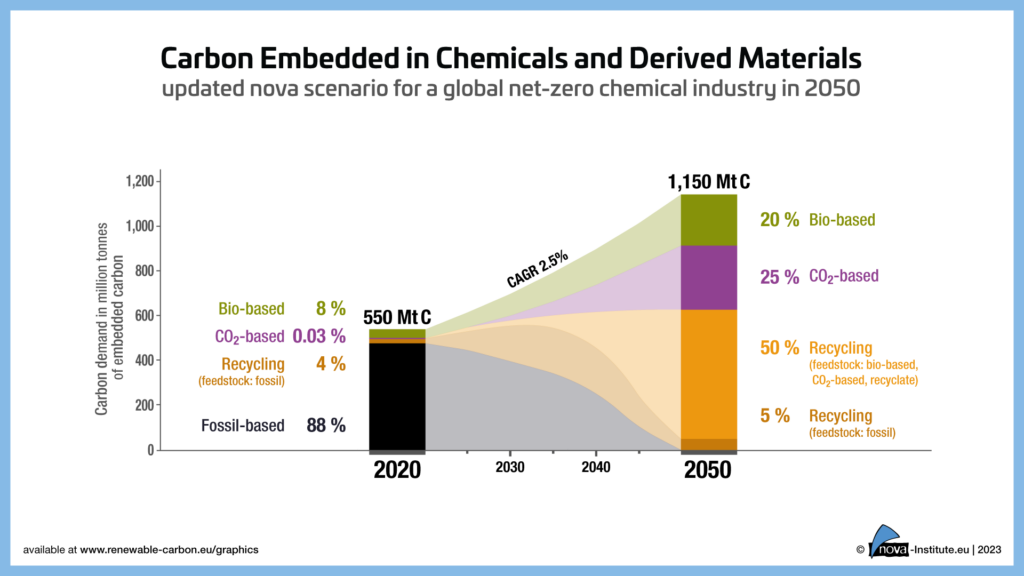The figure shows a so-called explorative scenario that is based on plausible assumptions on the basis of which the future is to be explored. What are the consequences of such a scenario? This is deliberately not a prediction, as the occurrence of the scenario depends above all on political framework conditions and corresponding investments. It will not become reality by itself.
The update from October 2023 includes development paths from 2020 to 2050 (see below).
What are the assumptions behind the scenario?
CAGR = 2,5% is in line with other studies and about 1% lower than in previous decades. This lower growth is mainly based on efficiency improvements as well as reservations towards plastics, which are replaced in some areas e.g. by cellulose/paper.
Shares of the different renewable carbon sources for chemicals and derived materials
Current policy focuses clearly on recycling, primarily mechanical recycling. For the fractions that cannot be recycled mechanically, chemical recycling becomes a key option. Various studies see a maximum overall recycling rate of 50 to 60%. When it comes to plastics only, even 70% can probably be achieved. However, since the total quota also includes detergents and solvents, we have set 55% in the scenario, which is ambitious in any case.
The limitation of the biomass share to 20% results mainly from limited areas available for cultivated biomass and planted forest. The limitation is mainly based on the need to preserve biodiversity, which is increasingly becoming a focus of sustainability, also in policy. About a quarter of the area (that supplies the 20% of biomass) comes from land that was previously used for biofuels but is now being freed up by ongoing electrification.
The remaining 25% is covered by direct utilisation of CO2 (from point sources and direct air capture), which represents only a small share of the possible potential of CO2 utilisation.
A first study to evaluate the consequences of the exploratory scenario has already been conducted. It shows that in principle even the entire carbon demand of the chemical industry worldwide could be covered by direct utilisation of CO2 – and with an energy demand that would require “only” 1.3% of the Sahara desert used for photovoltaic (Kähler et al. 2022).
In the here presented scenario, mainly the commodities of the chemical industry are produced from utilisation of CO2 and chemical recycling, while special molecules with particularly favourable pathways are produced from biomass, e.g. fine chemicals or polyamides from castor oil and PLA from lactide acid.
Development from 2020 to 2050
The October 2023 update shows a steady increase in the share of bio-based chemicals from 8% in 2020 to 20% in 2050. CO2-based chemicals require a lot of investment to become relevant after 2030, with strong growth between 2040 and 2050. The recycling of virgin fossil chemicals and plastics dominates the recycling sector until 2035. After 2035, bio-based, CO2-based and recyclates increasingly dominate the recycling sector.
You find all nova figure in high resolution here: https://renewable-carbon.eu/publications/?search=1&publication-type=graphics
And the figure below: https://renewable-carbon.eu/publications/product/explorative-scenario-carbon-embedded-in-chemicals-and-derived-materials-png/
You are invited to use the figure in your presentations (please cite with the link to the nova download page), but please always use the latest version.

Source
nova-Institute, press release, 2023-10-27.
Supplier
Share
Renewable Carbon News – Daily Newsletter
Subscribe to our daily email newsletter – the world's leading newsletter on renewable materials and chemicals












